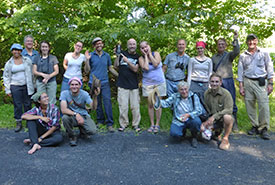Clarenceville Bog BioBlitz

Clarenceville bog BioBlitz (Photo by NCC)
When people asked what I was doing over the weekend, and I replied “Going to a bog,” the reactions ranged from puzzled faces to outright laughter. In the acoustic sense, the word “bog” isn’t particularly charming. And perhaps there’s a reason for that — the first men or women charged with the pleasure of naming this damp and deathly environment may have felt they did so deservingly.
The French version of the word, on the other hand, sounds much better, at least in my opinion. The “tourbière” de Clarenceville is found roughly one hour’s drive from the City of Montréal. Enclosed by agricultural land, the bog has been owned by the Nature Conservancy of Canada (NCC) for a decade.
With just a rough map sectioning the area into different habitat types, a team of NCC staff and volunteers recently set out on a hot summer Saturday to conduct a species inventory of the area, looking out particularly for rare species.
Dividing into small groups based on our areas of expertise (such as botany, ornithology, herpetology and entomology), we spread out into the bog, following the almost-formed paths trod by hunters. Led by the talented botanist Caroline Tanguay, our group received a short briefing outlining the more common plants that we were likely to see, followed by instructions to alert the group of any rare species sightings.
As one of the group’s designated ornithologists, my attention was initially drawn to the trees, on the lookout for fleeting movements between branches. But as the other group members began pointing and calling out in excitement, my focus shifted to the path ahead, scanning the carpet of green in an attempt to register the minute details that categorize the plant world.
While doing so I experienced an almost fantastical sensation, as though a new unseen dimension was emerging from the damp boggy path and spreading far beyond.
As we worked our way through the bog, our leader Caroline was particularly excited to reach a cédrière (cedar forest) located at the southern end. Here we navigated the more sparse and water-logged ground with steps and jumps across drier elevated patches.
My newly found attention to the ground below revealed orange mushrooms that grew up from the earth like gangling fingers and carnivorous plants that capture their prey with hairy, clam-like snap traps.
With the day moving on, we reluctantly started back to rejoin the other teams, agreeing on a route that inadvertently meant fighting our way through dense tree cover, until the ground suddenly made way for more blueberry bushes than I have ever seen. Meeting forest once again, we soon found ourselves separated from the road home by a small yet impassable river. Our wayward travels were rewarded, however, by the discovery of a rare fern species, distinguished by its fine, delicate leaf divisions.
Navigating our way around the obstructive river, which apparently posed less of a challenge to an industrious beaver, we reached the road and were reunited with our fellow bog explorers. After a wrap-up and exchange of information regarding our day and discoveries, we made our way back home.
With satisfactorily soggy boots and muddy clothes, and a body tired in the best kind of way, I fantasized about the prospect of finding a comfortable surface to collapse on — which might seem ironic after spending the day walking on such soft, spongy, moss-covered ground on which one could only really imagine the most heavenly of nymphs making their bed.
While spotting a nymph might be unlikely, the water-logged nature of bogs does make them home to a number of unique, specialized flora and fauna. In just one day, collectively our efforts identified many species and allowed an ecologically important site to be better known. Perhaps spending a Saturday at a bog isn’t such a ridiculous idea after all.


